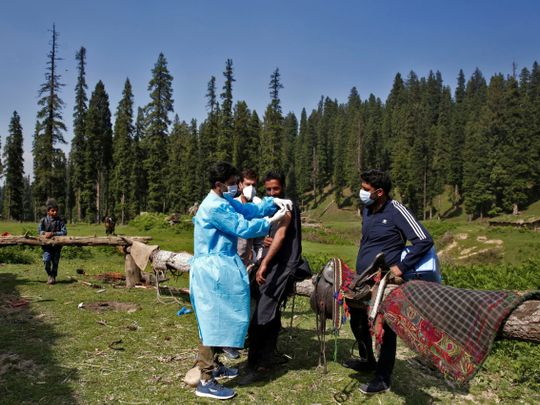
New Delhi: India will need to spend an additional 800 billion rupees ($11 billion) to provide free vaccines and food to millions of people devastated by the deadly coronavirus wave, people with knowledge of the matter said.
The government will earmark an additional 700 billion rupees for providing food to the poor and other eligible groups until November, said the people, who asked not to be identified as the numbers aren’t public. The administration will need an extra 100 billion rupees to provide free vaccinations, they said.
Prime Minister Narendra Modi agreed on Monday to provide free inoculations, reversing a policy where states ended up competing for supplies for certain age categories, leading to severe shortages.
In an address on national television, Modi said all Indians above age 18 can be vaccinated for free starting June 21, to speed up the inoculation drive.
The government may not have to tap the bond market for the funds, the people familiar said, citing the 991.2 billion-rupee dividend the government received from the central bank and expected inflows from asset sales. With the extra money, the government will end up spending a total of 1.3 trillion on providing food, the people said, and has set aside 350 billion rupees for vaccinations in the budget.
* India has been giving an average of 2.4 million shots a day. Health officials say this is far from adequate for a country as large as India. “We need to vaccinate 7-8 million persons per day to meet the target of covering all the eligible persons before the end of December,” Giridhara Babu, a member of the Indian Council of Medical Research (ICMR), the country’s main health research agency, told Reuters.
* Daily infections have fallen and officials aim to switch the focus to mass vaccinations. India reported 86,498 new cases overnight, the lowest number in over two months and a sharp drop from a peak of around 400,000 a day in May.
* India has been inoculating its people with AstraZeneca shots produced at the Serum Institute of India, and Covaxin made by Indian firm Bharat Biotech. It is set to commercially launch Russia’s Sputnik V in mid-June. One reason for the low coverage is that supplies are tight.
A finance ministry spokesman declined to comment.
Even after accounting for the bumper dividend from the Reserve Bank of India and better growth numbers that should result in higher tax revenue, the “fiscal math will likely worsen,” said Madhavi Arora, an economist with Emkay Global Financial Services Ltd. in Mumbai. That’s because of higher payouts on food and fertiliser subsidies as well as for a rural jobs-guarantee programme. There’s also a risk that the asset-divestment program could raise less money than anticipated.
“Amid various push and pull there is a likelihood of fiscal slippage, to the tune of around 0.5 per cent from the initially budgeted 6.8 per cent of gross domestic product,” she added, referring to the expected fiscal deficit.
India has administrated 232 million doses since the world’s biggest vaccination drive began Jan. 16, with 3.4% of the population now fully immunized. At that pace, it will take another 22 months to cover 75% of the population, according to the Bloomberg Vaccination Tracker.








